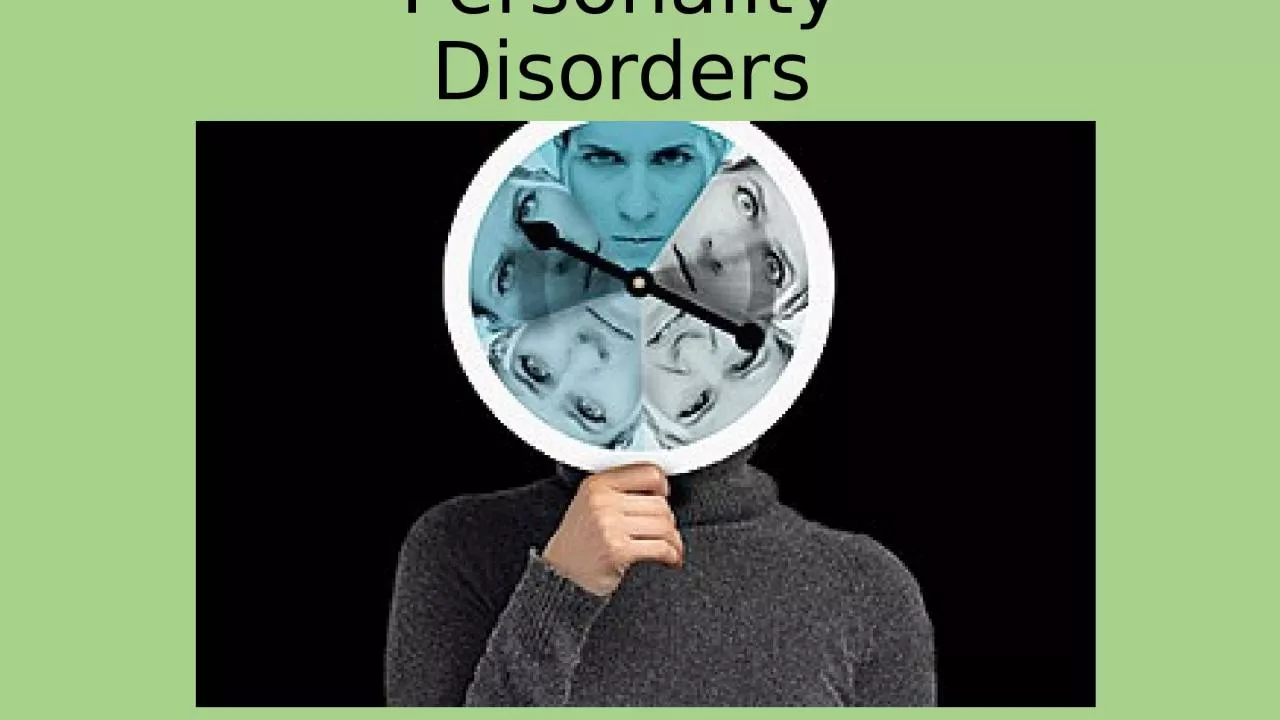

DSMIV lists 10 separate personality disorders with an average prevalence of 12 Three clusters anxiousfearful oddeccentric and dramaticimpulsive Concern Categorical vs Dimensional DSMV ID: 914629
Download Presentation The PPT/PDF document "Personality Disorders Personality disord..." is the property of its rightful owner. Permission is granted to download and print the materials on this web site for personal, non-commercial use only, and to display it on your personal computer provided you do not modify the materials and that you retain all copyright notices contained in the materials. By downloading content from our website, you accept the terms of this agreement.
Slide1
Personality Disorders
Slide2Personality disorders are marked by extreme, inflexible, personality traits that impair normal functioning
DSM-IV lists 10 separate personality disorders, with an average prevalence of 1-2%
Three clusters: anxious-fearful, odd-eccentric, and dramatic-impulsiveConcern: Categorical vs. Dimensional (DSM-V)?Are not diagnosed until age of 18
Slide3Anxious/Fearful Personality Disorders
Avoidant
: overly sensitive to potential rejection; socially withdrawn (50/50)
Dependent
:
lacking in self-reliance/esteem; overly subordinate to all (30/70)Obsessive-Compulsive: preoccupied with rules, lists, detail; overly conventional, serious; unable to express warm emotions (50/50)
Slide4Odd/Eccentric P.D.’s
Schizoid
: defective in capacity for social relationships; absence of warmth of others (78/22)
Paranoid:
Pervasive unwarranted suspiciousness and mistrust; jealous & sensitive
(67/33)Schizotypal: deficits in social relationships, odd thinking, and perception (55/45)
Slide5Dramatic/Impulsive P.D.’s
Histrionic:
overly dramatic, exaggerated emotion, egocentric, attention seeking (15/85)Narcissistic:
success fantasies, delusions of grandeur, lacking interpersonal empathy
(70/30)
Borderline: unstable in self-image, mood, and relationships; impulsive (38/62)Antisocial: violates rights of others/social norms, failure to form attachments,
(82/18)
Slide6Antisocial Personality Disorder
Not withdrawn, or recluse from society, but failing in making long-term lasting relationships
Known usually as ‘charming, witty, manipulative, without remorse’3%-6% in males; 1% in femalesEnter criminal world at a young age, and sometimes channel amoral behavior into high-power statuses
Manson:
http://www.youtube.com/watch?v=f9jRDHGabp8
Slide7Antisocial P.D. and Serial Killers
Antisocial
p.d. is not causational of being a serial killer, but it is correlationalSerial killer vs. spree killerASPD is common within criminals and incarcerated males and females (one study showed over 35%)
ASPD has been present in most infamous serial killers in U.S.
Dahmer:
http://www.youtube.com/watch?v=ErB0R4wlB64
Bundy (final):
http://www.youtube.com/watch?v=dYAxfdj5_hY
Bundy (defense):
http://www.youtube.com/watch?v=tf1II4uRLXE
Slide8Treatment
Depending on disorder, some are more treatable
Most disorders are chronic, many need multi-dimensional help for lifetimeBiological: anti-anxiety meds, anti-depressants, anti-psychotics
Cognitive:
client-centered, rational emotive behavior therapy, dialectical therapy (learning coping behaviors)
Social: group therapy, family therapy, etc.Note: many cases of ASPD, and sometimes other PD’s, are difficult to treat, and may take constant care